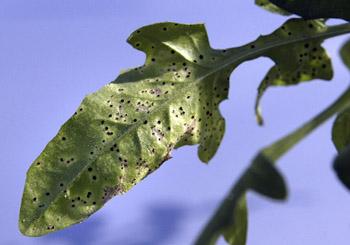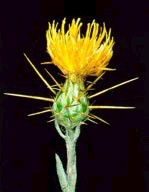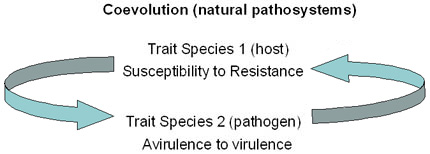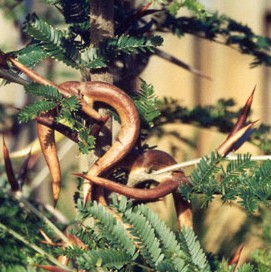Coevolution occurs between interacting populations when genetic change occurs in each in response to the change in the other. In other words, there is reciprocal genetic change in two populations that directly results from the interaction between them.
 Rusts are plant diseases caused by fungus and infect many species, including cultivated oats, barley, wheat, sunflowers, as well as most wild plants. The spores cause lesions on leaves or stems and are usually wind-dispersed.
Rusts are plant diseases caused by fungus and infect many species, including cultivated oats, barley, wheat, sunflowers, as well as most wild plants. The spores cause lesions on leaves or stems and are usually wind-dispersed.Starthistle is an invasive plant that occurs in most of the United States, including Arizona, and is susceptible to a leaf rust. Within the plant population, some individuals possess a mutation that recognizes a gene product of the pathogen and, thereby, the plant can resist the infection. The rust reduces the fitness of susceptible plants, which lack the mutation. The resistant plants will produce more offspring and, thus, the resistance mutation will increase in frequency and spread through the population of starthistles.
 As the resistance in the plant population increases as a result of an increase in the frequency of resistant individuals, the ability of the pathogen to reproduce is reduced and the overall level of disease decreases. At this point, there is selection for individuals in the pathogen population that have a mutation causing the loss or a change in the shape of its gene product so that it is no longer recognized by the plant. Thus, the rust becomes a virulent disease again. Once the mutation to virulence occurs, the frequency of the virulence allele increases in the rust population, leading to an increase in the amount of disease in the previously resistant plant population. And the cycle begins again.
As the resistance in the plant population increases as a result of an increase in the frequency of resistant individuals, the ability of the pathogen to reproduce is reduced and the overall level of disease decreases. At this point, there is selection for individuals in the pathogen population that have a mutation causing the loss or a change in the shape of its gene product so that it is no longer recognized by the plant. Thus, the rust becomes a virulent disease again. Once the mutation to virulence occurs, the frequency of the virulence allele increases in the rust population, leading to an increase in the amount of disease in the previously resistant plant population. And the cycle begins again.Many theories predict that plant alleles for resistance and susceptibility, and pathogen alleles for virulence and avirulence should coexist in natural populations for a long time. Theories also predict that coevolution will occur at the fastest pace in places where the amount of disease is greatest.

There are many other examples of coevolution, many of which probably involve multiple genes in both populations.
Mutualism. Good evidence for insect/plant coevolution is found in the Central American plant known as "bullshorn Acacia", Acacia cornigera.
 This plant is similar to other members of the genus Acacia (thorn trees in the pea family), in that it has large spines which presumably protect it against mammalian herbivores (another example of coevolution, presumably against mammalian browsers). However, it lacks the cyanogenic glycosides (cyanide-producing chemicals) found in related Acacia and the thorns in this species are particularly large and hollow, and provides shelter to a species of Pseudomyrmex ant. The plant also provides proteinaceous food bodies on the tips of the leaflets, which sustain the ant colonies. These ants are particularly nasty, and are well able to deter even mammals with their wasp-like stings. It has been shown experimentally that the ants will also remove any caterpillars from the leaves that they patrol. The ants even remove vines and plants from around the base of the tree, creating a bare patch on the soil. Plants of the bullshorn Acacia which have not been occupied by ant colonies are heavily attacked by herbivores and often have vines growing in the branches.
Related Acacia species lack hollow thorns and food bodies, and do not have specific associations with ants. They also have many cyanogenic glycosides in their leaves. These data strongly support the idea that the bullshorn Acacia has evolved a close, mutualistic association with the ants which protects themselves from herbivores (and also plant competitors). It also supports the idea that the cyanogenic glycosides found in other species have a defensive role; a role which has been taken over by Pseudomyrmex in the bullshorn Acacia.
This plant is similar to other members of the genus Acacia (thorn trees in the pea family), in that it has large spines which presumably protect it against mammalian herbivores (another example of coevolution, presumably against mammalian browsers). However, it lacks the cyanogenic glycosides (cyanide-producing chemicals) found in related Acacia and the thorns in this species are particularly large and hollow, and provides shelter to a species of Pseudomyrmex ant. The plant also provides proteinaceous food bodies on the tips of the leaflets, which sustain the ant colonies. These ants are particularly nasty, and are well able to deter even mammals with their wasp-like stings. It has been shown experimentally that the ants will also remove any caterpillars from the leaves that they patrol. The ants even remove vines and plants from around the base of the tree, creating a bare patch on the soil. Plants of the bullshorn Acacia which have not been occupied by ant colonies are heavily attacked by herbivores and often have vines growing in the branches.
Related Acacia species lack hollow thorns and food bodies, and do not have specific associations with ants. They also have many cyanogenic glycosides in their leaves. These data strongly support the idea that the bullshorn Acacia has evolved a close, mutualistic association with the ants which protects themselves from herbivores (and also plant competitors). It also supports the idea that the cyanogenic glycosides found in other species have a defensive role; a role which has been taken over by Pseudomyrmex in the bullshorn Acacia.
Population Genetics of Plant Pathogens
BIOL B242 - COEVOLUTION